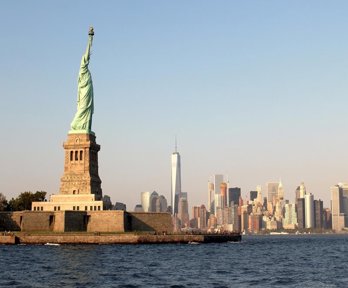The aim of this unit is to introduce pupils to the key features of the United States of America (USA). It provides a framework for understanding the different environments present within the USA: the key physical features, where populations are distributed, and some of the interactions between the human and physical environments focusing on food, farming and water. The unit provides a number of case studies of different places throughout the USA, and even takes a historical perspective of one city in particular, New York, to examine how a settlement can develop over time.
The unit begins with an introduction to the USA, and some key features and locations that will be explored in greater detail later. The unit then shifts to explore the distribution of key physical landscapes and the formation of the Grand Canyon, introducing processes of erosion. The unit then considers the human landscapes of the USA exploring patterns of population distribution and density. The following lesson begins to consider interactions between human and physical environments by examining the impact of floods in Mississippi and droughts in California. Lesson five explores key issues related to food and farming in the USA, highlighting key relationships between the physical and human environment and interdependencies between the two. The unit then focuses on one settlement in particular, New York City, to explore how this city has developed over time into its modern form. The assessment for this unit is formed of two parts: a multiple choice quiz and an activity where pupils take on the role of British Ambassador to the USA.
The module is designed to provide an overview of the different features of the USA including both physical and human landscapes, as well as the interactions between them and the important issues that these interactions create. Pupils will develop strong locational and place knowledge of the USA, as well as an understanding of how this region is different from the United Kingdom.
United States of America: an exploration
This lesson introduces pupils to the country USA, focusing on key human and physical features. This lesson familiarises pupils with the region and its varied geographies.
Main activities:
-
Pupils are provided with a series of images of features and places in the USA. They will sort them into categories to introduce them to different types of features they will be studying in the unit.
-
Map based exercise requires pupils to plot features on the map including countries, settlements, rivers etc.
-
Sounds are played to pupils and they try to match them with each image.
Canyons and valleys: physical landscapes
This lesson now moves on to consider the USA in closer detail. The aim of this lesson is to build on the pupils’ understanding of the physical. They will begin the lesson by watching a time lapse video to move through different landscapes and then move on to examine how the Grand Canyon formed.
Main activities:
-
Watch time lapse video which journeys across a number of inspiring landscapes in the USA. Pupils are instructed to note down words that they can think of to describe these landscapes to try and create an A to Z of the USA. Class discussion to follow this activity to provide accurate descriptions of the landscapes and to provide an explanation of how they formed.
-
Discussion based exercises explore the processes of erosion and examine how the Grand Canyon formed. This leads into a demonstration activity of how river erosion works.
Where are all the people?
This lesson focuses on the distribution of human beings in the USA and provides insights into the different types of settlements across the country. This lesson involves pupils comparing the demographic characteristics of different states in the USA.
Main activities:
-
Examining population change in the USA over time, followed by a card sort activity to examine reasons why some places are more populated than others.
-
Creation of a map which shows the most populous cities, most populous states and least populous states.
-
Data handling activity using USA census data to explore a range of different settlements in the USA and their key demographic characteristics.
Challenged by water: floods and drought
This lesson considers key interactions between physical and human landscapes, in particular the impact of water supply distributed across the country and what happens during water related disaster events.
Main Activities:
-
Lesson begins with an exploration of how the climate differs across the USA.
-
The two following exercises involve pupils comparing different climatic regions of the USA using climate graphs. Class divided into two: one half will first explore the impact of floods from the Mississippi. Activity will result in the creation of a storyboard of events. The other half of the class will explore how drought conditions are affecting the state of California. Pupils can swap activities half way through the lesson.
Food and farming
Pupils are introduced to the different foods associated with the USA, and agricultural products grown there. In particular it encourages pupils to think about the different factors that can affect farming in the USA.
Main activities:
-
Pupils encouraged to bring in foods that have come from the USA.
-
Pupils presented with a list of the top producing states for a number of key agricultural products and then add these to a map of the USA.
-
Role play activity which explores different farming activities in the USA and the challenges that are faced (prices, demand, pests, environmental conditions).
New York through time
This lesson focuses on exploring the development of New York City through time, with clear cross-curricular links with history.
Main Activities:
-
In group discussion, pupils establish what they know, or recognise about New York and how they know it (exploring sources/representations of the city in film, music, television).
-
Then pupils will explore how New York has changed, through historical maps and images.
-
In groups pupils will explore what New York City was like during different time periods and complete a ‘then and now’ activity worksheet that explores development in different areas of the city.
Assessment
-
The assessment for this unit is formed of two parts:
-
A multiple choice quiz which tests knowledge of each lesson in the unit.
-
For the second part pupils take on the role of British Ambassador to the United States. Pupils are presented with a scenario where a new ambassador will be arriving to take over and they need to produce a guide with important information about the USA based on the top 10 things they have learnt throughout the unit.
About the author
Dr Jennifer Ferreira is a researcher in the Centre for Business in Society at Coventry University and a former writer of the Royal Geographical Society’s education resources. She is also a tutor on the Geographical and Environment courses at Villiers Park Education Trust. Her doctoral research at the University of Manchester focused on changing labour markets in Europe and her current research interests surround issues related to economic development.


